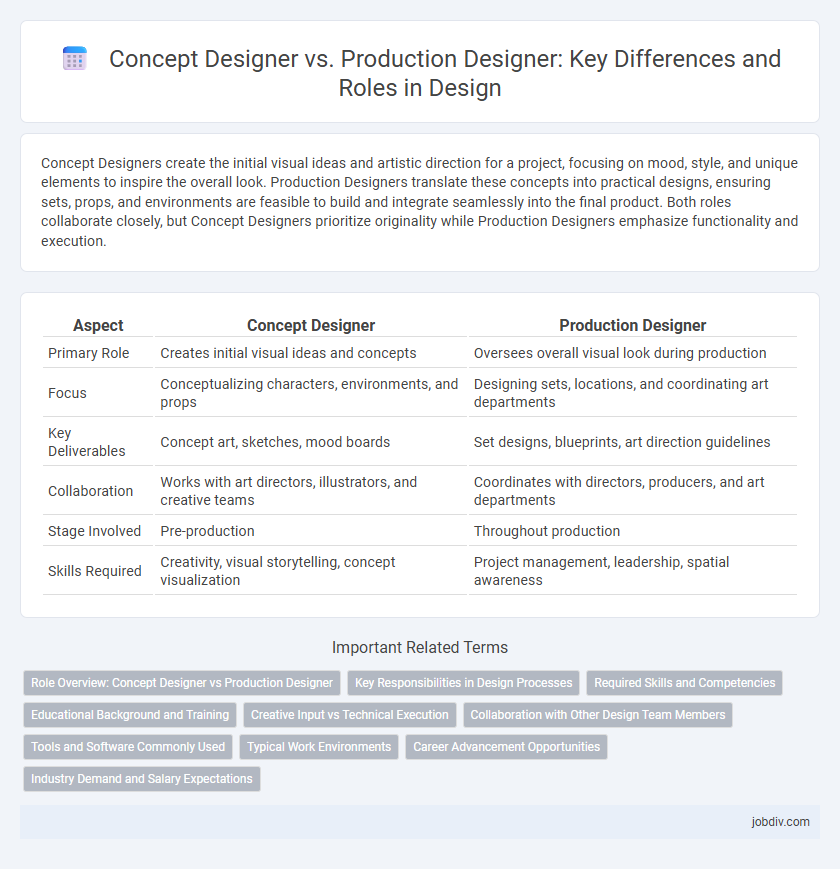Concept Designers create the initial visual ideas and artistic direction for a project, focusing on mood, style, and unique elements to inspire the overall look. Production Designers translate these concepts into practical designs, ensuring sets, props, and environments are feasible to build and integrate seamlessly into the final product. Both roles collaborate closely, but Concept Designers prioritize originality while Production Designers emphasize functionality and execution.
Table of Comparison
| Aspect | Concept Designer | Production Designer |
|---|---|---|
| Primary Role | Creates initial visual ideas and concepts | Oversees overall visual look during production |
| Focus | Conceptualizing characters, environments, and props | Designing sets, locations, and coordinating art departments |
| Key Deliverables | Concept art, sketches, mood boards | Set designs, blueprints, art direction guidelines |
| Collaboration | Works with art directors, illustrators, and creative teams | Coordinates with directors, producers, and art departments |
| Stage Involved | Pre-production | Throughout production |
| Skills Required | Creativity, visual storytelling, concept visualization | Project management, leadership, spatial awareness |
Role Overview: Concept Designer vs Production Designer
A Concept Designer specializes in creating initial visual ideas and exploratory sketches that define the artistic direction of a project, focusing on innovation and creativity during early development stages. A Production Designer, on the other hand, translates these concepts into practical, detailed designs, overseeing the execution of sets, props, and environments to ensure consistency and functionality throughout production. Their collaborative roles bridge the gap between artistic vision and tangible realization in industries like film, gaming, and advertising.
Key Responsibilities in Design Processes
Concept Designers develop initial visual ideas and creative concepts, focusing on brainstorming, sketching, and mood boards to establish the artistic direction. Production Designers oversee the practical implementation of the design, managing set construction, material selection, and ensuring alignment with the project's visual style and technical requirements. Both roles collaborate closely but differ in that Concept Designers prioritize innovation and creativity, while Production Designers emphasize feasibility and execution within the design process.
Required Skills and Competencies
Concept Designers excel in creativity, strong visual communication, and proficiency in digital sketching tools like Adobe Photoshop and Illustrator, emphasizing ideation and exploration of innovative visuals. Production Designers require comprehensive knowledge of project management, technical construction, and collaboration skills to translate concepts into feasible, high-quality final products. Both roles demand a keen eye for detail and adaptability, but Concept Designers prioritize artistic vision while Production Designers focus on practical execution and resource coordination.
Educational Background and Training
Concept designers typically possess formal education in fine arts, graphic design, or industrial design, emphasizing creativity, visual storytelling, and rapid prototyping skills. Production designers often hold degrees in film, theater, or interior design programs, with specialized training in set construction, materials, and project management to translate concepts into physical environments. Both roles benefit from strong collaboration skills and proficiency in design software, but production designers require deeper technical knowledge to oversee the practical execution of visual concepts.
Creative Input vs Technical Execution
Concept Designers prioritize creative input by developing original ideas, visual storytelling, and thematic frameworks that guide a project's artistic direction. Production Designers focus on technical execution, transforming concepts into tangible environments, coordinating with technical teams, and ensuring design feasibility within budget and time constraints. The balance between innovative vision and practical implementation defines the collaborative dynamic between these roles in the design process.
Collaboration with Other Design Team Members
Concept Designers and Production Designers collaborate closely with other design team members, ensuring a seamless transition from initial ideas to final execution. Concept Designers contribute visionary sketches and mood boards that guide the creative direction, while Production Designers focus on practical implementation and materializing designs within budget and technical constraints. This synergy fosters innovation and efficiency, aligning artistic goals with production realities.
Tools and Software Commonly Used
Concept Designers primarily utilize digital painting and illustration software such as Adobe Photoshop, Corel Painter, and Procreate to create detailed visual concepts and storyboards. Production Designers depend on comprehensive tools like Autodesk Maya, SketchUp, and Adobe After Effects to translate these concepts into practical designs for set construction, lighting, and visual effects. Both roles often collaborate using project management platforms like ShotGrid or Trello to streamline workflow and ensure alignment throughout the design and production process.
Typical Work Environments
Concept Designers primarily work in creative studios or agency settings where collaboration with art directors and illustrators is essential to develop visual concepts for projects. Production Designers often operate within film sets, television studios, or game development companies, managing practical aspects like set design, props, and overall visual continuity. Both roles may involve remote work but differ markedly in on-site presence due to the hands-on nature of Production Design.
Career Advancement Opportunities
Concept designers often have greater opportunities for creative innovation and portfolio development, which can lead to roles in art direction or senior design positions. Production designers typically advance by gaining expertise in project management and technical execution, positioning themselves for roles such as creative director or studio manager. Both career paths offer distinct advancement routes depending on an individual's strengths in creativity or operational leadership within the design industry.
Industry Demand and Salary Expectations
Concept Designers command strong industry demand in interactive media and advertising, driven by their role in visualizing ideas during early project stages. Production Designers see higher salary expectations in film and television due to overseeing overall aesthetic continuity and managing large teams. Salary data from Glassdoor indicates average annual earnings of $70,000 for Concept Designers versus $90,000 for Production Designers, reflecting their differing responsibilities and sector demands.
Concept Designer vs Production Designer Infographic

 jobdiv.com
jobdiv.com